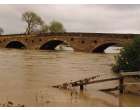|
What caused the floods…..?
On 8 and 9 April 1998, a slow-moving depression gave rise to torrential rain over eastern Wales and the central region of England. The consequences were exacerbated by the blocking effects of an anticyclone centred over Scandinavia, causing the rain-bearing air mass to remain virtually stationary over the central Midlands for almost two days, and leading to many affected areas recording rainfall totals in excess of 75 millimetres over a 36 hour period - roughly equal to 6 weeks of average April rainfall in one and a half days.
To see satellite weather pictures (40k), click here.
In the previous weeks, there had been above average rainfall. So the already saturated nature of the land worsened the impact, leading to excessive surface runoff in upper reaches and widespread flooding further downstream. Rivers rose at rates twice that previously recorded and reached record heights in many places.
…..and what were the consequences?
The resulting floods were the worst on record for
an area of 5,000 square kilometers bounded by Bedford in the east,
Evesham in the west, Peterborough in the north and Oxford in the
south. Over 4,200 properties were affected in England and Wales.
Northampton and Leamington Spa were particularly badly hit. Record
breaking floods hit the river catchments of the Leam, Avon, Nene,
Great Ouse and Cherwell. The design specification of existing flood
defences proved insufficient; and bear in mind that many of these
were built to withstand floods with a 1 in 100, or a 1 in 150 year
return period. Losses were estimated at £700 million, making
it the UK's fourth largest insurance loss ever.
The Environment Agency sums it up.. "Five people died directly or indirectly as a result of the floods. Many people were, without warning, put in fear of death or serious injury. They lost their homes and personal possessions,suffered massive disruption to their lives and livelihoods, and some are still without permanent homes six months later. Some victims are experiencing ill health, chronic anxiety and other symptoms of traumatic stress."
Read the full Environment Agency's report into what happened, and what lessons can be learned.
Or read the summary of the Benfield Greig Hazard Research Centre (683k pdf file download)
[Back to top]
Are we likely to see more floods in future?
The likelihood of flooding similar in scale to 1998 recurring has been estimated as a "50 to 100 year event". But the world is warming. Globally 1998 was the warmest year since records began in 1860, while in the UK 1999 was the hottest year since 1659.
Climate change from the burning of fossil fuels such as coal, oil and gas could mean more floods in the future. Severe rainstorms and heavy flooding are predicted to happen more often as climate change takes hold, both in the UK and around the world. Individual flooding events cannot be attributed directly to climate change but do give us an indication of what may lie in store.
The turn of the millennium saw devastating floods in Venezuela, where heavy and prolonged rains caused mudslides killing up to 30 000 people. Just days later tornado-force winds up to 200 kph (120 mph) tore through Western Europe killing over 100 people and causing damages estimated at 10 billion Euros. In France some 360 million trees were uprooted or snapped in two leaving foresters to face huge losses. Meanwhile two French nuclear reactors were flooded by storm waters damaging important equipment. In the UK thousands of acres of low-lying farmland were inundated after the worst floods to hit Somerset in living memory. And all this less than two years after our own Easter Floods.
Worldwide, more people die in floods than through any other natural disaster. Although not on the same scale, floods in the UK also endanger lives, homes, businesses and farmland and cause tremendous stress and disruption. In England and Wales an estimated 1.6 million homes and businesses are at risk from flooding. Flooding is a natural hazard but it is influenced by human activities such as land use changes,river engineering and urbanisation. And now there is the added threat of climate change.
For a view on the possible effects of global warming, visit the Friends of the Earth website.
[Back to top]
Be prepared
Hopefully, the floods of 1998 were a "once in a lifetime" event, but if the worst should happen again and your property is under threat of flooding, how can you prepare? What should you do during a flood? What's the best way to cope afterwards?
In October 1999 (and largely in response to the Easter Floods of 1998), the Environment Agency launched its £2 million flood campaign to raise public awareness of individual flood risk. So to answer these questions, and to find out more about flood warning services and flood defence work, visit the Environment Agency's website.
You can check their Flood
risk maps.
Or call the Environment Agency FloodLine on 0845 988 1188
[Back to top]
|


